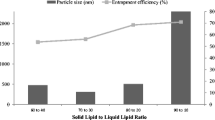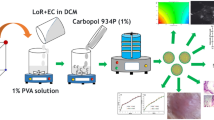Abstract
The aim of the present research was to optimize cryogel formulation of Diltiazem hydrochloride (DZ) with poly(vinyl alcohol) (PVA) and hydroxypropyl methylcellulose (HPMC) by utilizing response surface methodology followed by ex vivo permeation study on the optimized gel containing penetration enhancers. A 3-level factorial design was employed to formulate the experimental runs and to evaluate the effect of two independent variables such as the concentration of PVA and HPMC on characteristics of cryogel such as bioadhesive strength (BS) and in vitro drug release (dependent variables). Response surface plots such as contour and 3D plots were generated by the Design Expert® software to analyze the effect of independent variables on dependent variables. Fourier transform infrared spectroscopy studies confirmed the absence of interaction between DZ and polymers. Among various models generated by the software, quadratic model was found to be best fit for both the responses. Both the formulation factors influenced BS synergistically. However, the effect of HPMC concentration was more pronounced compared to concentration of PVA. But, an opposite effect shown by both the formulation factors on cumulative percentage of drug release (CPR) in 8 h. The optimized batch of cryogel of DZ selected by the software was having composition of 5 % of PVA and 2 % of HPMC. Penetration enhancers such as 1,8-cineole, d-limonene and carvone were incorporated into the optimized gel and permeation study was carried out using abdominal skin of rat. The study demonstrated a highest flux of 118 ± 5.81 µg/cm2/h in case of 1,8-cineole containing gel followed by carvone and d-limonene.





Similar content being viewed by others
References
Adibkia K, Shokri J, Barzegar-Jalali M, Solduzian M, Javadzadeh Y (2014) Effect of solvent type on retardation properties of Diltiazem HCl form liquisolid tablets. Colloid Surf B 113:10–14
Agrawal V, Gupta V, Ramteke S, Trivedi P (2010) Preparation and evaluation of tubular micelles of pluronic lecithin organogel for transdermal delivery of sumatriptan. AAPS PharmSciTech 11:1718–1725
Ahad A, Al-Jenoobi FI, Al-Mohizea AM, Aqil M, Kohli K (2013) Transdermal delivery of calcium channel blockers for hypertension. Expert Opin Drug Deliv 10:1137–1153
Ahad A, Aqil M, Ali A (2014) Investigation of antihypertensive activity of carbopol valsartan transdermal gel containing 1,8-cineole. Int J Biol Macromol 64:144–149
Amnuaikita C, Ikeuchia I, Ogawaraa K, Higakia K, Kimura T (2005) Skin permeation of propranolol from polymeric film containing terpene enhancers for transdermal use. Int J Pharm 289:167–178
Andrisano V, Hrelia P, Gotti R, Leoni A, Cavrini V (2001) Photostability and phototoxicity studies on diltiazem. J Pharm Biomed Anal 25:589–597
Aqil M, Ahad A, Sultana Y, Ali A (2007) Status of terpenes as skin penetration enhancers. Drug Discov Today 12:1061–1067
Bagchi S, Li W, Plakogiannis F (2012) Optimization and prediction of drug release from matrix tablets using response surface methodology and near infrared chemical imaging. Pharm Dev Technol 17:398–406
Bilensoy E, Rouf MA, Vural I, Sen M, Hincal AA (2006) Mucoadhesive, thermosensitive, prolonged release vaginal gel for clotrimazole: β-cyclodextrin complex. AAPS PharmSciTech 7:125–130
Brannon-Peppas L (1990) Preparation and characterization of cross linked hydrophilic networks. In: Brannon-Peppas L, Harland RS (eds) Absorbent polymer technology. Elsevier, Amsterdam, pp 45–66
Chang J-S, Huang Y-B, Hou S-S, Wang R-J, Wu P-C, Tsai Y-H (2007) Formulation optimization of meloxicam sodium gel using response surface methodology. Int J Pharm 338:48–54
Chu JS, Amidon GL, Weiner ND, Goldberg AH (1991) Mixture experimental design in the development of a mucoadhesive gel formulation. Pharm Res 8:1401–1407
El-Kattan AF, Asbill CS, Michniak BB (2000) The effect of terpene enhancer lipophilicity on the percutaneous permeation of hydrocortisone formulated in HPMC gel systems. Int J Pharm 198:179–189
Emma JW, Gavin PA, Mc Coy CP, Jones DS (2013) The effect of dilute solution properties on poly(vinyl alcohol)films. J Mech Behav Biomed Mater 28:222–231
Galya T, Sedlařík V, Kuřitka I, Novotný R, Sedlaříková J, Sáha P (2008) Antibacterial poly(vinyl alcohol) film containing silver nanoparticles: preparation and characterization. J Appl Polym Sci 110:3178–3185
Gao S, Singh J (1998) In vitro percutaneous absorption enhancement of a lipophilic drug tamoxifen by terpenes. J Control Release 51:193–199
Gendy AME, Jun HW, Kassem AA (2002) In-vitro release studies of flurbiprofen from different topical formulations. Drug Dev Ind Pharm 28:823–831
Hu L, Silva SMC, Damaj BB, Martin R, Michniak-Kohn BB (2011) Transdermal and transbuccal drug delivery systems: enhancement using iontophoretic and chemical approaches. Int J Pharm 421:53–62
Huang M, Yang M (2008) Evaluation of glucan/poly(vinyl alcohol) blend wound dressing using rat models. Int J Pharm 346:38–46
Huang YB, Tsai YH, Yang WC, Chang JS, Wu PC (2004) Optimization of sustained release propranolol dosage form using factorial design and response surface methodology. Biol Pharm Bull 27:1626–1629
Hwang M-R, Kim JO, Lee JH, Kim YI, Kim JH, Chang SW, Jin SG, Kim JA, Lyoo WS, Han SS, Ku SK, Yong CS, Choi H-G (2010) Gentamicin-loaded wound dressing with polyvinyl alcohol/dextran hydrogel: gel characterization and in vivo healing evaluation. AAPS PharmSciTech 11:1092–1103
Jain E, Srivastava A, Kumar A (2009) Macroporous interpenetrating cryogel network of poly(acrylonitrile) and gelatin for biomedical applications. J Mater Sci 20:173–179
Jana S, Manna S, Nayak AK, Sen KK, Basu SK (2014) Carbopol gel containing chitosan-egg albumin nanoparticles for transdermal aceclofenac delivery. Colloid Surf B 114:36–44
Kim JO, Choi JY, Park JK, Kim JH, Jin SG, Chang SW, Li DX, Hwang MR, Woo JS, Kim JA, Lyoo WS, Yong CS, Choi HG (2008a) Development of clindamycin-loaded wound dressing with polyvinyl alcohol and sodium alginate. Biol Pharm Bull 31:2277–2282
Kim JO, Park JK, Kim JH, Jin SG, Yong CS, Li DX, Choi JY, Woo JS, Yoo BK, Lyoo WS, Kim JA, Choi HG (2008b) Development of polyvinyl alcohol–sodium alginate gel-matrix-based wound dressing system containing nitrofurazone. Int J Pharm 359:79–86
Li X, Zhang R, Liang R, Liu W, Wanga C, Su Z, Sun F, Li Y (2014) Preparation and characterization of sustained-release rotigotine film-forming gel. Int J Pharm 460:273–279
Marana JP, Priya B (2014) Ultrasound-assisted extraction of polysaccharide from Nephelium lappaceum L. fruit peel. Int J Bio Macromol 70:530–536
Marasini N, Yan YD, Poudel BK, Choi HG, Yong CS, Kim JO (2012) Development and optimization of self-nanoemulsifying drug delivery system with enhanced bioavailability by Box–Behnken design and desirability function. J Pharm Sci 101:4584–4596
Molden E, Bøe GH, Christensen H, Reubsaet L (2003) High-performance liquid chromatography/mass spectrometry analysis of diltiazem and 11 of its phase I metabolites in human plasma. J Pharm Biomed Anal 33:275–285
Nesseem DI, Eid SF, El-Houseny SS (2011) Development of novel transdermal self-adhesive films for tenoxicam, an anti-inflammatory drug. Life Sci 89:430–438
Ochoa M, Mousoulis C, Ziaie B (2012) Polymeric microdevices for transdermal and subcutaneous drug delivery. Adv Drug Deliv Rev 64:1603–1616
Păduraru OM, Vasil C, Patachia S, Grigoras C, Oprea AM (2010) Membranes based on poly(vinyl alcohol)/β-cyclodextrins blends. Polimery 5:473–478
Park K (1997) Controlled release: challenges and strategies. American Chemical Society, Washington
Pawde S, Deshmukh K (2008) Characterisation of polyvinyl alcohol/gelatin blend hydrogel films for biomedical applications. J Appl Polym Sci 109:3431–3437
Pazos V, Mongrain R, Tardif JC (2009) Polyvinyl alcohol cryogel: optimizing the parameters of cryogenic treatment using hyperelastic models. J Mech Behav Biomed Mater 2:542–549
Peppas NA (1997) Hydrogels and drug delivery. Curr Opin Colloid Interface Sci 2:531–537
Peppas NA, Langer R (1994) New challenges in biomaterials. Science 263:1715–1720
Peppas NA, Mikos AG (1986) Preparation methods and structure of hydrogels. In: Peppas NA (ed) Hydrogels in medicine and pharmacy. CRC Press, Boca Raton, pp 1–27
Peppas NA, Bures P, Leobandung W, Ichikawa H (2000) Hydrogels in pharmaceutical formulations. Eur J Pharm Biopharm 50:27–46
Prausnitz MR, Langer R (2008) Transdermal drug delivery. Nat Biotechnol 26:1261–1268
Quaglia MG, Donati E, Fanali S, Bossu E, Montinaro A, Buiarelli F (2005) Analysis of diltiazem and its related substances by HPLC and HPLC/MS. J Pharm Biomed Anal 37:695–701
Ratner BD, Hoffman AS (1976) Synthetic hydrogels for biomedical applications. In: Andrade JD (eds) Hydrogels for medical and related applications, ACS symposium series, no. 31, American Chemical Society, Washington DC, p 1–36
Rhee YS, Chang SY, Park CW, Chi SC, Park ES (2008) Optimization of ibuprofen gel formulations using experimental design technique for enhanced transdermal penetration. Int J Pharm 364:14–20
Samavati V (2013) Polysaccharide extraction from Abelmoschus esculentus: optimization by response surface methodology. Carbohydr Polym 95:588–597
Singh S, Parhi R, Garg A (2011) Formulation of topical bioadhesive gel of aceclofenac using 3-level factorial design. Iran J Pharm Res 10:435–445
Sung JH, Hwang M-R, Kim JO, Lee JH, Kim YI, Kim JH, Chang SW, Jin SG, Kim JA, Lyoo WS, Han SS, Ku SK, Yong CS, Choi H-G (2010) Gel characterisation and in vivo evaluation of minocycline-loaded wound dressing with enhanced wound healing using polyvinyl alcohol and chitosan. Int J Pharm 392:232–240
Varshosaz J, Tavakoli N, Saidan S (2002) Development and characterization of a periodontal bioadhesive gel of metronidazole. Drug Deliv 9:127–133
Williams AC, Barry BW (1991) Terpenes and the lipid-protein-partitioning theory of skin penetration enhancers. Pharm Res 8:17–24
Williams AC, Edwards HGM, Lawson EE, Barry BW (2006) Molecular interaction between the penetration enhancer 1,8-cineole and human skin. J Raman Spectrosc 37:361–366
Willimann H, Walde P, Luisi PL, Gazzaniga A, Stroppolo F (1992) Lecithin organogel as matrix for transdermal transport of drugs. J Pharm Sci 81:871–874
Worth AP, Cronin MTD (2001) The use of pH measurements to predict the potential of chemicals to cause acute dermal and ocular toxicity. Toxicology 169:119–131
Xua X, Yang Y-Q, Xing Y-Y, Yanga J-F, Wang S-F (2013) Properties of novel polyvinyl alcohol/cellulose nanocrystals/silver nanoparticles blend membranes. Carbohydr Polym 98:1573–1577
Yonga CS, Choi JS, Quan Q-Z, Rhee J-D, Kim C-K, Lim S-J, Kim K-M, Oh P-S, Choi H-G (2001) Effect of sodium chloride on the gelation temperature, gel strength and bioadhesive force of poloxamer gels containing diclofenac sodium. Int J Pharm 226:195–205
Zhao K, Singh J (2000) Mechanism(s) of in vitro percutaneous absorption enhancement of tamoxifen by enhancers. J Pharm Sci 89:771–780
Acknowledgments
This article does not contain any studies with human and animal subjects performed by any of the authors. All authors (R. Parhi, P.Suresh, S. Patnick) declare that they have no conflict of interest.
Author information
Authors and Affiliations
Corresponding author
Rights and permissions
About this article
Cite this article
Parhi, R., Suresh, P. & Patnaik, S. Formulation optimization of PVA/HPMC cryogel of Diltiazem HCl using 3-level factorial design and evaluation for ex vivo permeation. Journal of Pharmaceutical Investigation 45, 319–327 (2015). https://doi.org/10.1007/s40005-015-0179-y
Received:
Accepted:
Published:
Issue Date:
DOI: https://doi.org/10.1007/s40005-015-0179-y




